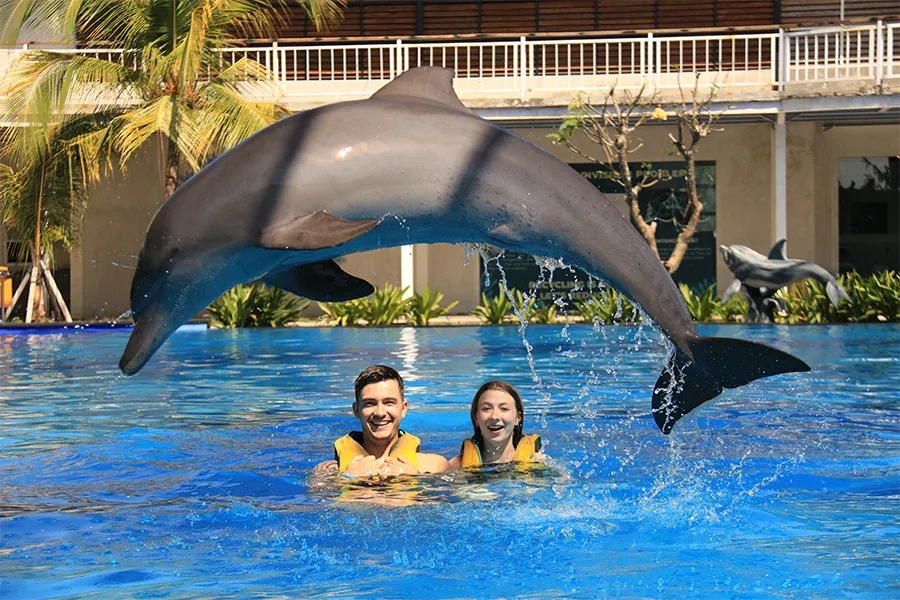How Long Can Bali Dolphins Survive Out of Water?
A common question that is often asked is “can Bali dolphins breathe underwater?” The answer is no, dolphins cannot breathe underwater – but while dolphins need to breathe oxygen to survive, they are still aquatic and must stay hydrated in order to survive. Dolphins can survive out of water for several hours if the water is kept wet and cool. One of the biggest dangers to dolphins out of the water is their inability to regulate their body temperature. We will explain how dolphins regulate their blood temperature and the negative effects that being out of the water for too long can have on dolphins.
How Do Dolphins Regulate Their Body Temperature?
Dolphins are warm-blooded and need to maintain a steady body temperature of 96-97 degrees Fahrenheit. Since dolphins do not have sweat glands, they regulate their body temperature through thermoregulation. Bali dolphins can regulate their body temperature in several ways:
- Fat – dolphins’ blubber can insulate their bodies from extreme temperature changes
- Surface Area – dolphins can release heat from the surface of their bodies such as their tail fins and dorsal fins
- During Dives – when they dive, dolphins can reduce blood circulation to channel more efficiently to their organs.
- Change Environment – dolphins can move to cooler or warmer waters as needed to help regulate their body temperature.
Because dolphins rely on their environment to help regulate their body temperature, dolphins may face the potential negative effects of overheating if their environment becomes too hot. So, if they are out of the water in warmer weather, they run the risk of overheating because they are unable to regulate their body temperature.
How Long Can Bali Dolphins Hold Their Breath?
Bali dolphins can survive out of the water for quite some time if they are kept wet and at the right temperature, but how long can they stay in the water before they need to breathe again? Although dolphins cannot breathe underwater, they can still hold their breath for long periods of time. The average dolphin can hold their breath underwater for eight to ten minutes. Some species of dolphins can even stay underwater for up to fifteen minutes! This gives them the power to make long dives where they can catch fish and other prey.
How Do Dolphins Breathe?
The dolphins’ breathing process works very similarly to that of whales. Like whales, Bali dolphins have a nozzle located on the top of their heads, where they release CO2 and leave the air in their lungs. When the dolphin needs to take a breath, it comes to the surface of the sea and exhales before taking another breath. During a powerful exhale, the dolphin will spray water out into the ocean, creating what is known as a dolphin “spray.” When navigating the deep blue sea in search of marine life, many ship captains will use whale and dolphin jets to spot species from long distances!
Why do Balinese dolphins blow bubbles?
Dolphins are animals that love to bubble! As air-breathing marine mammals, dolphins produce various types of bubbles for various reasons. They create circles and channels of bubbles, sometimes even while making notes. But that’s not all—when they are surprised, curious, or happy, they release what is known as a ‘bubble burst’.
Unlike other mammals, Bali dolphins have complete voluntary control over their breathing, which is essential for their aquatic lifestyle. While making simple circles of bubbles may be easy, making constant circles shows that dolphins may have a degree of practice, skill, and planning.
Why do dolphins play?
Play is an important part of the lives of dolphins in Bali, serving many important roles for individuals and groups. Play is a training ground for young dolphins, where they hone their essential locomotor skills. These skills are not just for fun; they are essential for foraging and mating tactics.
Social skills are another important factor that is explored through play. Dolphins get to know their peers, gaining insight into their personalities and tendencies. This social learning provides a space for cognitive development and development. In fact, young dolphins are a special source of new play behaviors, which are sometimes picked up by the entire group, thus creating a more social learning environment.
In addition, the complexity of play patterns increases as peers of the same age are involved. This suggests that play has a multi-layered role, contributing to the development of problem-solving skills, social and communicative capabilities, and the strengthening of social bonds.
Do dolphins have self-awareness?
Recent scientific research suggests that dolphins are indeed among the few animals that show signs of self-awareness.
Dolphins demonstrate the power of self-awareness. They can examine body parts that are usually hidden from view, such as the inside of their mouths, and move their bodies in unusual ways to see their reflections in mirrors.
Dolphins have been shown to display emotions such as empathy and grief over the loss of a companion, which can be seen as a form of self-awareness.
This is the very reason why it is cruel to keep dolphins in captivity in marine parks and zoos around the world.
To see dolphins, whales, and other marine life in their natural environment, we invite you to experience Bali dolphin watching at Bali Exotic Marine Park! We promise a thrilling journey that the whole family will love and remember for years to come. Contact us for ticket information via whatsapp or call +62 853-3883-3678 today. We look forward to seeing you at Bali Exotic Marine Park soon!
